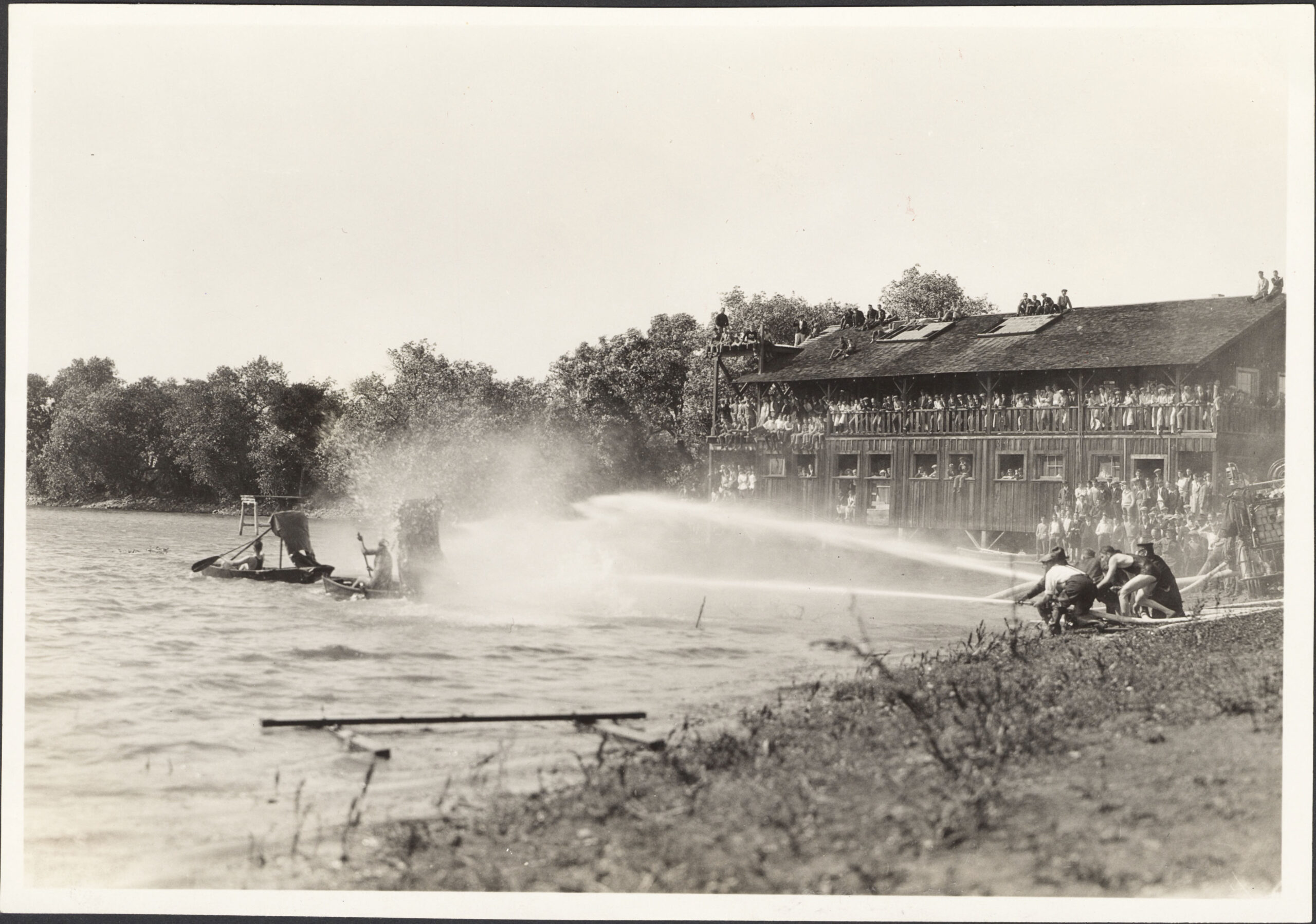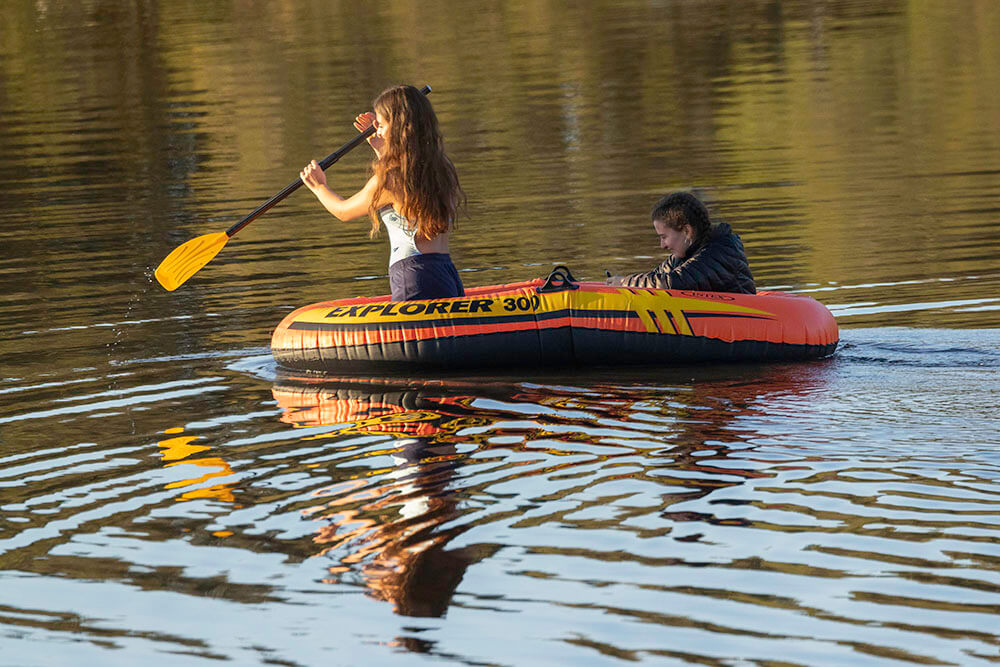Words by Bob Siegel
The recent rains have delivered many gifts to the Peninsula, including a bit of respite from the ongoing drought. On the Stanford campus, a welcome sight has been the reemergence of Lake Lagunita—the campus’ most notable water feature.
Just a short walk from the nearest public parking at Tresidder Student Union, Lake Lagunita pre-dates Stanford University and was built as a 115-million-gallon reservoir to provide water for fruit orchards and other crops growing on the Stanfords’ Palo Alto Stock Farm.
Combining English and Spanish, Lake Lagunita redundantly translates to “Lake Little Lake.” Even more confusing, in recent years, Lagunita typically presents as a dry bowl and not a lake at all. But this winter, water has transformed Lagunita into a mecca for wildlife and student life, harkening back to an earlier epoch when the lake played a more pivotal role. As John Cobbs observed in the The Stanford Daily in 1940, “…romance on campus varies directly with the water gauge on the lake.”
Lagunita has always undergone an annual cycle—drying up in the warm days of summer and starting to refill with the autumn rains. Upon returning to campus after winter break, students were greeted by the soothing appearance of water in the lake. And so it is again…in 2023.

Awash With History
Known to many as “Lake Lag,” Lagunita’s rich and colorful history has been preserved through a bounty of testimonials and photographs. From the year that Stanford University opened in 1891, the lake became a significant focus of student social life. Some of the most sought-after dorms in the annual housing lottery abutted the lake.
Images that predate the 1906 earthquake are notable for the presence of a large spire on Stanford Memorial Church and the gigantic Memorial Arch, neither of which was ever restored.
Once a bustling hub, Lagunita’s boathouse went through several iterations before being permanently demolished in 1989.
In the fall, Lagunita hosted a giant bonfire in the build-up to the Big Game against Cal, where cross-Bay rivals meet on the football field. The annual bonfire moved to the lakebed in 1936 and continued until 1993, when the practice was suspended over concerns about the ecological impact on endangered salamanders.

The coming of spring signaled the onset of shoreline recreation and watersports, including swimming, sunbathing, picnicking, boating and sailing classes. One particularly notable event was the annual Spring Water Carnival, with various races and competitions. One involved the launching of cardboard boats—not so much to see how fast you could go, but how far—before the cardboard became saturated and collapsed, depositing inhabitants into the lake.
Lake Lagunita Highlights 1877 Workers begin construction on a new water system for the Palo Alto Stock Farm 1880 Lakebed is excavated by mule-drawn scrapers, lined with clay and tramped down by sheep 1891 Stanford University opens its doors on October 1 with an enrollment of some 550 students 1892 Students erect a makeshift boathouse on the shore 1893 Spectators gather to witness “the first race ever rowed at Stanford” 1913 Campus YMCA completes construction on a central boathouse 1935 Following heavy rainfall, the lake surpasses previous records by filling with 117 million gallons of water and registering a depth of over 20 feet 1936 The traditional Big Game bonfire is held in Lagunita’s dry lakebed for the first time 1938 Overcrowding causes the boathouse balcony to collapse during the annual Water Carnival, seriously injuring two people 1939 New boathouse is built; wood from the fallen one is used as fuel for the Big Game bonfire 1951 Bonfire pyre reaches a record height of 85 feet 1967 Local high school students release an alligator into the lake; five weeks later it is caught 1970 Boathouse is declared unsafe 1975 Spring Aqua Follies tradition is revived 1977 Bonfire is suspended due to safety and air quality concerns; a fireworks show is held instead 1985 Bonfire returns to Lake Lagunita 1989 Following a brief Bon Voyage ceremony, the 50-year-old boathouse is torn down 2001 Stanford stops manually filling the reservoir for recreation, resulting in a dry lakebed in subsequent drought years Present Record rainfall temporarily replenishes Lake Lagunita Courtesy of The Stanford Daily and Anthony Kirk
Lake Lagunita Dries Up
Lake Lagunita is surrounded by an earthen berm, with rain runoff from the foothills below the Stanford Dish providing some of its water. But Lagunita is mainly fed by Los Trancos and San Francisquito Creeks, which derive their water from two upstream artificial lakes on campus: Felt Lake and Searsville Lake. Stanford University controls the amount of water available for Lagunita. Near the golf course, there is an outlet so that rising waters do not overtop the dam and threaten the adjacent buildings.
Since the 1970s, a full lake has been a relative rarity. “The lake has seldom been filled as a result of natural rainfall, even in the wettest years,” Former Associate Vice Provost for Facilities Chris Christofferson once explained. “The lake bottom is extremely porous, and leaks 500 gallons per minute when it is full. So, to keep it full, it would require pumping an enormous amount of water. This would be extremely expensive.”
In 2001, Stanford stopped manually filling the reservoir for recreational use, and when drought years took their toll, Lake Lagunita evolved into a starkly different vista: a parched, dry basin.

Lake Lagunita Reappears
In the wake of record-breaking winter storms, Lake Lagunita once again entices walkers, birders, art students and studious undergrads looking for a change of scenery. This aqueous bounty also produces memorable landscapes, vibrant sunsets and abundant photographic opportunities.
At nearly a mile, the lake’s perimeter trail serves as the main locus of activity. Unfortunately, one part of the path is temporarily flooded, creating an impassable obstacle for hikers and joggers hoping to circumnavigate the lake.
One huge difference now is that use of the actual lake is prohibited. “Danger,” the signs read. “Do not enter water. No drinking, swimming or recreational activities.” Despite these restrictive measures, some students find the allure of water too great, wandering out in inflatable dinghies and even homemade watercraft.
The University cites health and ecological reasons for the ban, ranging from an annoying itchy skin condition and submerged broken bottles to the lake being a threatened species habitat. The site acts as a breeding ground for the endangered and protected California tiger salamander. A pervasive mythology asserts that the salamanders are the reason that the lake is not filled every year. It only takes a moment of reflection to realize the flaw in this argument; namely, amphibians love water.
A Welcome Mat for Wildlife
As with the salamanders, the many posted warnings are not a deterrent to myriad forms of wildlife: frogs, lizards, snakes, gophers, squirrels and a profusion of birds.
The return of water has been particularly attractive for birds. On the lake itself can be found ducks, grebes and coots. Various herons patrol the edge of the lake patiently looking for tasty morsels in the shallow water or on the banks. The oaks and other large trees on the perimeter trail are filled with a wide variety of perching birds: nuthatches, robins, titmice, phoebes, juncos and crows, as well as several species of woodpeckers and raptors keeping watch from above. Bird watchers flocking to the lake also display a variety of ages, motivations and equipment.
While the birds quickly grab our attention, mammals like rabbits and gophers are generally more secretive. Also sharing hidden domains are beetles, slender salamanders, centipedes, woodlice and several species of millipedes, including one that appears fluorescent under UV light at night. In contrast to the more elusive critters, lady beetles proudly display their colors, warning would-be predators to stay away.
The observant visitor will also marvel at the diverse assortment of fungi. As the mycophiles are fond of saying, “When it rains, it spores.” Some fungi pop up from the ground with the canonical shape of mushrooms, others hang from trees or form gelatinous structures on decaying wood.
Slime molds may look like fungus, but their common name is misleading as they are actually in a completely different kingdom—the protozoa (Phylum: Mycetozoa). Found nestled in Lagunita’s crevices or under decaying wood, the curious creatures we see after it rains are extremely transient, often living a few days to weeks.

Nature Wonders
Whether the lakebed is dry or wet, all of Lagunita’s discoveries are a delight to the curious. In recent years, a student-organized “bioblitz” has been held each spring. Open to members of the community, participants explore and document all manner of life. With the help of campus biologist Alan Launer, what they find is sometimes quite surprising including lizards, frogs and several species of snakes. Seeing, interacting with and learning about these creatures at close range is fascinating at every age. The event is also a wonderful opportunity to meet old and new friends with a shared interest in nature and the environment.
Beholding the gift of Lake Lagunita’s robust reappearance, one can only hope the future will see many more seasons with a full lake and the pleasures of lacustrine pursuits.
Lake Lagunita Spring Bioblitz
Check stanfordseeds.weebly.com for details.



